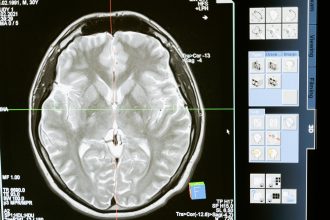A penetrating brain injury occurs when an object breaks through the skull and damages the brain tissue beneath. Unlike closed head injuries, where the skull remains intact, penetrating injuries cause direct trauma to brain structures. These injuries are often life-threatening and require immediate emergency care.
Although less common than concussions or strokes, penetrating brain injuries are among the most severe types of brain trauma. Survivors may face significant challenges in mobility, communication, memory, and behavior, depending on which parts of the brain were affected.
Causes of Penetrating Brain Injury
Penetrating injuries can occur in a variety of situations, including:
- Gunshot wounds – the most common cause in adults, with high fatality rates.
- Shrapnel or blast injuries – seen in military combat or explosions.
- Industrial or workplace accidents – tools, machinery, or debris penetrating the skull.
- Stabbings or assaults – sharp objects such as knives.
- Severe accidents – high-speed crashes or falls with bone fragments piercing the brain.
What Happens in the Brain
When the skull is breached, several types of damage can occur:
- Primary injury: Direct destruction of brain tissue along the object’s path.
- Secondary injury: Bleeding, swelling, infection, or pressure changes that cause additional damage.
- Foreign material: Bullets, bone fragments, or debris left in the brain can worsen injury and complicate treatment.
Symptoms
Symptoms depend on the region of the brain injured, but may include:
- Loss of consciousness at the time of injury
- Seizures
- Bleeding from the head or nose
- Weakness or paralysis on one side of the body
- Vision, hearing, or speech loss
- Memory loss, confusion, or personality changes
Emergency care is required immediately after injury.
For more information on identifying concerning signs, see Brain Injury Symptoms & Warning Signs.
Diagnosis
Doctors quickly assess penetrating brain injuries using:
- CT scans – the fastest way to detect foreign objects, bleeding, and swelling.
- MRI scans – for more detailed follow-up once the patient is stable.
- Surgical evaluation – neurosurgeons determine whether objects or fragments can safely be removed.
Treatment
Treatment typically involves:
- Emergency stabilization – airway management, controlling bleeding, and stabilizing blood pressure.
- Surgery – to remove objects, bone fragments, or blood clots, and to repair skull fractures.
- Infection prevention – antibiotics and sterile wound management are critical.
- Rehabilitation – once stable, patients begin therapy to restore lost functions.
See our full guide on Brain Injury Rehabilitation.
Complications
Penetrating brain injuries carry high risks of complications, including:
- Infections (meningitis, brain abscess) due to open skull wounds
- Seizures and post-traumatic epilepsy
- Hydrocephalus (fluid buildup in the brain)
- Severe cognitive and behavioral changes
- Persistent motor impairments such as weakness or paralysis
Recovery and Outlook
The outcome depends on:
- The type and speed of medical intervention
- The location and extent of brain damage
- The patient’s age and overall health
- Access to rehabilitation services
Some survivors regain independence with therapy, while others may require long-term care. Families should prepare for a long recovery journey, with the possibility of lasting changes in personality, behavior, or ability to perform daily activities.
Prevention
While many penetrating injuries occur in unpredictable, violent events, prevention strategies include:
- Firearm safety and violence prevention programs
- Workplace and construction site safety regulations
- Helmet use in high-risk activities
- Military protective equipment and training
Conclusion
Penetrating brain injuries are among the most severe forms of brain trauma, demanding immediate medical attention and long-term rehabilitation. Survival and recovery depend on the speed of emergency care and the resources available for rehabilitation.
Though rare compared to concussions or strokes, these injuries highlight the importance of safety measures, awareness, and access to specialized care.






